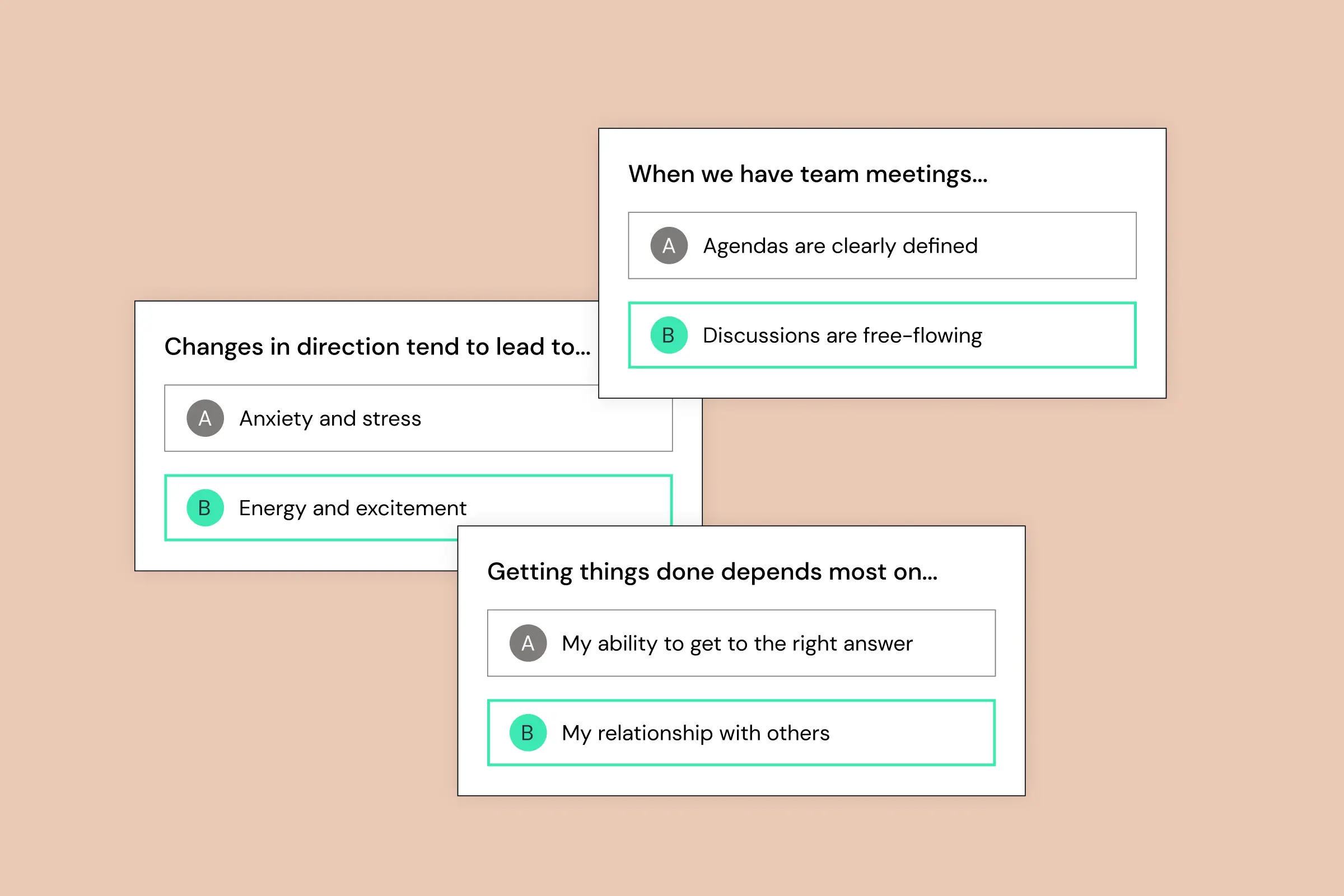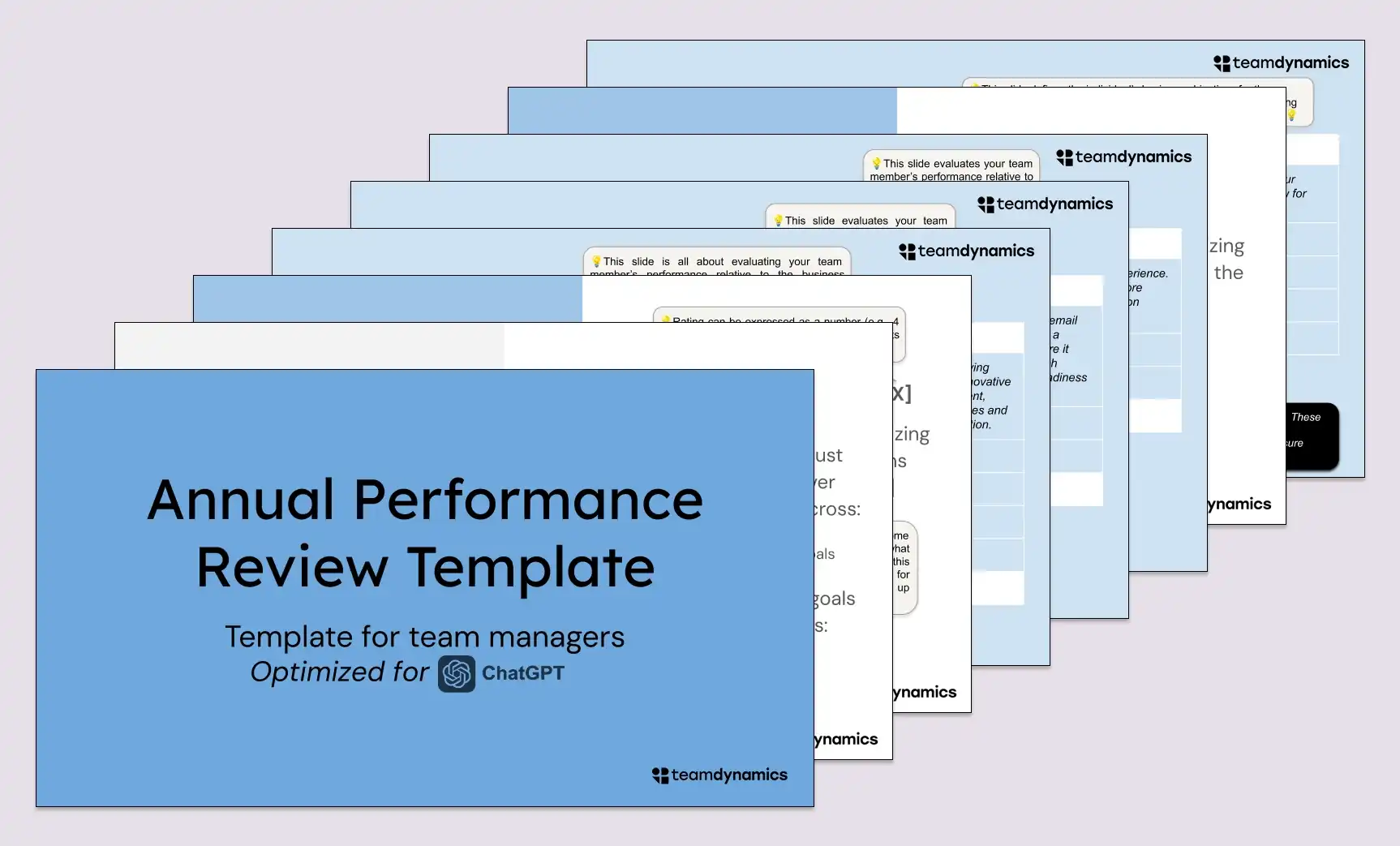Giving feedback is one of the most powerful tools a manager can use to shape the performance and culture of a team. Whether it’s praising a job well done, guiding an employee through challenges, or correcting behavior, feedback helps team members understand what’s expected of them and how they can improve.
In a fast-paced professional environment, the way feedback is delivered can make or break a team’s morale and productivity. Positive feedback reinforces good behavior and motivates employees, while constructive and negative feedback provides crucial guidance for growth and correction. But getting feedback right isn’t always easy—especially when it comes to maintaining a balance between being direct and being supportive.
Looking for a copilot in your next round of feedback? Learn how to use ChatGPT to give employee feedback!
In this blog post, we’ll explore different examples of feedback—positive, constructive, and negative—that managers can use to inspire and guide their teams. We’ll also touch on the importance of communication in delivering feedback effectively and how tools like TeamDynamics can help you give feedback that truly resonates with your team. By the end, you’ll have a clear understanding of how to deliver feedback that not only drives performance but also strengthens the bonds within your team.
Feedback in Communication
Role of Communication in Feedback
Effective communication is at the heart of delivering feedback that resonates and leads to positive change. How you communicate feedback can determine whether it’s received as constructive guidance or as criticism. Clear, direct, and empathetic communication ensures that your message is understood and accepted, paving the way for meaningful improvements.
Understanding your team dynamics can help you give better feedback.
Example 1: Using Clear, Direct Language
“I wanted to discuss the recent project handover. I noticed that some key details were missing from the documentation, which caused confusion for the receiving team. Moving forward, it’s important to include all necessary information in your handovers to avoid these issues. Let’s review what was missed this time and make sure it’s covered in the future.”
Impact: This feedback is delivered in straightforward language, leaving no room for misinterpretation. It clearly identifies the issue and provides a specific action to prevent it from happening again.
Example 2: Providing Feedback in a Timely Manner
“I appreciate your contributions during the last client meeting. However, I noticed that some of your responses were a bit off-topic, which made it difficult for the client to follow our main points. I wanted to bring this up now so we can work on refining our messaging before the next meeting. Let’s discuss how we can stay more focused on the core message.”
Impact: By delivering feedback shortly after the event, the feedback remains relevant and top-of-mind for the recipient. This ensures that the feedback is actionable and can be applied in the next similar situation.
Active Listening
Effective communication isn’t just about giving feedback; it’s also about listening. After delivering feedback, it’s important to give the team member an opportunity to respond. This shows that you value their perspective and are open to a dialogue. Active listening can also provide insights into any underlying issues that may be contributing to the problem, allowing you to address them more effectively.
{{inline-cta}}
Best Practices in Giving Feedback
Giving feedback effectively is a skill that can significantly impact your team’s performance and morale. To ensure your feedback is both constructive and well-received, here are some best practices to keep in mind:
1. Be Specific and Clear
General feedback like “Good job” or “You need to improve” doesn’t provide actionable insights. Instead, focus on specific behaviors or outcomes. For example, instead of saying, “Your work needs improvement,” say, “The report you submitted missed some key data points, which made it harder for the team to make decisions. Let’s ensure all relevant information is included in future reports.”
Why It Matters: Specific feedback helps the recipient understand exactly what they did well or where they need to improve, making it easier to repeat or correct the behavior.
2. Focus on Behavior, Not the Person
When giving feedback, it’s essential to address the behavior or outcome rather than the individual’s character or personality. For instance, say, “The presentation could have been more focused on the key metrics,” rather than, “You’re not good at presenting.”
Why It Matters: This approach reduces defensiveness and keeps the conversation focused on professional development rather than personal criticism.
3. Be Timely
Deliver feedback as close to the event as possible. Timely feedback is more relevant and easier for the recipient to connect with the specific action or behavior that prompted it.
Why It Matters: Immediate feedback allows for quick adjustments and ensures that the issue or praise is still fresh in the team member’s mind.
4. Balance Positive and Constructive Feedback
While it’s important to address areas for improvement, don’t forget to acknowledge what’s going well. A balanced approach, where constructive feedback is paired with positive recognition, helps maintain morale and encourages a growth mindset.
Why It Matters: Balancing feedback ensures that employees feel appreciated and motivated, even as they work on improving their performance.
5. Use the “Feedback Sandwich” Sparingly
The “feedback sandwich” method—where positive feedback is given before and after constructive criticism—can be effective in some situations. However, overuse can make it seem insincere. Use this technique carefully and only when it genuinely fits the situation.
Why It Matters: If used too frequently, the feedback sandwich can dilute the impact of both the positive and constructive feedback, making it less effective.
6. Encourage a Dialogue
Feedback should not be a one-way street. Encourage the recipient to share their thoughts, ask questions, and discuss how they plan to implement the feedback. This creates a more collaborative environment and helps ensure the feedback leads to actual improvement.
Why It Matters: Engaging in a dialogue shows that you value the recipient’s perspective and are committed to their growth, not just issuing commands.
7. Follow Up
After giving feedback, check in with the team member to see how they’re progressing. This follow-up shows that you’re invested in their development and helps reinforce the importance of the feedback.
Why It Matters: Following up demonstrates your ongoing support and helps to track the effectiveness of the feedback, ensuring long-term improvement.
Best Practices in Receiving Feedback
Receiving feedback can be challenging, especially when it’s critical. However, how you respond to feedback can significantly impact your personal and professional growth. Here are some best practices to help you make the most of the feedback you receive:
1. Listen Actively
When receiving feedback, focus on listening rather than preparing a response. Pay attention to what is being said without interrupting or becoming defensive. Take in the information fully before reacting.
Why It Matters: Active listening shows that you respect the feedback and the person giving it. It also ensures that you understand the feedback correctly before responding.
2. Stay Open-Minded
Approach feedback with an open mind, even if it’s difficult to hear. Try to see the feedback as an opportunity for growth rather than as criticism. Keep in mind that the person giving feedback likely has your best interests at heart.
Why It Matters: An open-minded attitude allows you to consider different perspectives and identify areas where you can improve, leading to better outcomes in the long run.
3. Ask for Clarification
If any part of the feedback is unclear, don’t hesitate to ask for clarification. This ensures that you fully understand the points being made and what is expected of you moving forward.
Why It Matters: Asking for clarification prevents misunderstandings and helps you know exactly what needs to be done to address the feedback.
4. Avoid Reacting Defensively
It’s natural to feel defensive when receiving critical feedback, but try to keep your emotions in check. Avoid making excuses or shifting blame. Instead, focus on understanding the feedback and how you can use it to improve.
Why It Matters: A defensive reaction can shut down the conversation and prevent you from benefiting from the feedback. Staying calm and composed allows for a more constructive dialogue.
5. Reflect on the Feedback
Take some time to reflect on the feedback after the conversation. Consider how it aligns with your own observations and experiences. Think about specific actions you can take to address the feedback.
Why It Matters: Reflection helps you process the feedback and develop a plan for making the necessary changes. It also gives you a chance to approach the situation with a clear mind.
6. Express Gratitude
Even if the feedback is tough to hear, thank the person for taking the time to provide it. A simple “Thank you for the feedback; I appreciate it” can go a long way in fostering a positive relationship.
Why It Matters: Expressing gratitude shows that you value the feedback and are committed to personal and professional growth. It also encourages a culture of open communication.
7. Take Action
The most important part of receiving feedback is what you do with it. Create a plan to address the feedback and make improvements where needed. If the feedback was positive, think about how you can continue to build on your strengths.
Why It Matters: Taking action demonstrates that you’re serious about improving and that you value the feedback you’ve received. It also helps you to turn feedback into tangible results.
8. Follow Up
After you’ve had some time to implement the feedback, consider following up with the person who gave it. Share the steps you’ve taken and ask for further input if needed.
Why It Matters: Following up shows that you’re committed to continuous improvement and value ongoing communication. It also helps to reinforce positive changes and build stronger working relationships.
Feedback Examples
Feedback comes in many forms, and each type serves a different purpose in helping your team grow and succeed. Whether you’re reinforcing positive behavior, guiding a team member through challenges, or addressing serious issues that need correction, the way you deliver feedback can make all the difference. In this section, we’ll explore real-life examples of various types of feedback—positive, constructive, and negative. These examples will show you how to communicate effectively in different situations, ensuring your message is clear, actionable, and ultimately beneficial for both the individual and the team.
Positive Feedback Examples
Positive feedback is a powerful tool for reinforcing good behavior, boosting morale, and encouraging continued excellence within your team. When delivered effectively, it not only makes the recipient feel valued but also sets a standard for the rest of the team. Here are five examples of positive feedback, each tailored to specific situations and following best practices.
1. Recognizing Outstanding Work on a Project
“I wanted to take a moment to acknowledge the fantastic job you did on the recent project. Your attention to detail and dedication to meeting the deadline were impressive. The client’s feedback was overwhelmingly positive, and that’s a direct result of your hard work. Keep up the great work—I’m excited to see what you’ll accomplish next!”
Why It Works: This feedback is specific and highlights both the effort and the outcome. By connecting the employee’s actions to the positive client feedback, you reinforce the value of their work and motivate them to continue excelling.
2. Praising Initiative and Innovation
“I really appreciate the initiative you took in developing a new approach to our marketing strategy. Your innovative ideas have opened up new opportunities for us and have already shown promising results. It’s clear that you’re thinking ahead and actively contributing to our team’s success. Great job—let’s keep pushing these ideas forward!”
Why It Works: This feedback recognizes initiative and innovation, which are critical for driving growth. By acknowledging the impact of the new strategy, you encourage the team member to continue thinking creatively and taking ownership of their contributions.
3. Complimenting Team Collaboration
“I wanted to commend you on how well you collaborated with the team during the recent campaign. Your ability to listen, integrate different perspectives, and drive the group toward a common goal was instrumental in our success. Your teamwork is a key strength that continues to benefit the entire team.”
Why It Works: This feedback is specific to the team member’s collaborative skills, emphasizing the importance of teamwork. It reinforces positive behavior that contributes to a cohesive and effective team environment.
4. Acknowledging Professional Growth
“I’ve noticed significant improvement in your presentation skills over the past few months. Your confidence and clarity have grown, and it’s been reflected in the positive feedback from our clients. It’s clear you’ve put in the effort to develop this skill, and it’s paying off. Keep building on this momentum—it’s great to see your growth!”
Why It Works: This feedback focuses on the individual’s professional development, recognizing the effort they’ve put into improving a specific skill. It encourages continued growth and shows that their progress has not gone unnoticed.
5. Commending Consistent High Performance
“I want to thank you for your consistent high performance. Week after week, you deliver quality work that sets a high standard for the rest of the team. Your reliability and dedication are truly appreciated, and they play a significant role in our ongoing success. Please know that your hard work doesn’t go unnoticed.”
Why It Works: This feedback acknowledges the employee’s ongoing contributions, reinforcing that consistent performance is valued just as much as standout achievements. It helps sustain long-term motivation and commitment to excellence.
These examples of positive feedback demonstrate how to recognize and reinforce valuable behaviors within your team. By being specific, timely, and sincere, you can ensure your feedback not only motivates but also sets the stage for continued success.
Constructive Feedback Examples
Constructive feedback is essential for guiding team members toward improvement and professional growth. It’s not about pointing out flaws but rather offering specific, actionable advice that helps individuals enhance their performance. Here are five examples of constructive feedback, each designed to address different situations while following best practices.
1. Improving Time Management
“I noticed that the last few reports were submitted just after the deadline. I understand that you’ve had a heavy workload recently, but meeting deadlines is crucial for keeping the project on track. Let’s look at how we can better prioritize your tasks or redistribute some responsibilities to help you manage your time more effectively. I’m here to support you in making these adjustments.”
Why It Works: This feedback is specific and addresses a recurring issue without being overly critical. It offers a collaborative solution, showing that you’re invested in helping the team member improve rather than simply pointing out the problem.
2. Enhancing Communication Clarity
“In our last meeting, some of your points were a bit hard to follow, and I think they may have caused some confusion among the team. Your ideas are valuable, so let’s work on refining how you present them. Perhaps we could do a quick review before the next meeting to ensure everything is clear and concise. This will help everyone understand your contributions more effectively.”
Why It Works: The feedback is focused on improving a specific skill—communication—while also offering a practical way to address the issue. By suggesting a review session, you’re providing support and showing a commitment to the team member’s success.
3. Addressing Attention to Detail
“I noticed a few minor errors in the data you submitted last week. While they didn’t have a major impact this time, accuracy is key to maintaining our credibility with clients. Let’s work on double-checking your work before submission to ensure everything is accurate. I’m confident that with a bit more attention to detail, you’ll continue to produce high-quality results.”
Why It Works: This feedback is specific about the issue and its potential consequences while also providing a clear, actionable step to prevent future mistakes. It maintains a positive tone by expressing confidence in the team member’s ability to improve.
4. Encouraging More Initiative
“I’ve noticed that you’ve been sticking closely to your assigned tasks, which is great for reliability, but I think you have the potential to take on more initiative. I’d love to see you propose new ideas or take the lead on smaller projects. This could be a great opportunity for you to grow and showcase your leadership abilities. Let’s discuss how you can start taking more ownership in areas where you feel confident.”
Why It Works: This feedback encourages the team member to step out of their comfort zone and grow. It’s framed positively, focusing on potential and opportunities rather than just pointing out a shortcoming.
5. Balancing Workload and Quality
“I’ve noticed that while you’re great at taking on multiple tasks, the quality of your work has slipped a bit recently, possibly due to the volume of tasks you’re managing. It’s important to balance workload with maintaining the high standards we’re known for. Let’s discuss how we can prioritize your tasks better or perhaps delegate some responsibilities to ensure that the quality doesn’t suffer while you manage a heavy workload.”
Why It Works: This feedback addresses the trade-off between quantity and quality in a constructive way. It acknowledges the team member’s willingness to take on work while also emphasizing the need for high standards. The suggestion of prioritizing or delegating tasks provides a practical solution.
These examples of constructive feedback demonstrate how to address issues in a way that encourages improvement and supports the team member’s growth. By being specific, focusing on behaviors, and offering actionable advice, you can help your team members develop their skills and contribute more effectively to the team.
Negative Feedback Examples
Negative feedback is necessary when serious issues arise that need immediate correction. While it can be difficult to deliver, negative feedback should be clear, direct, and focused on specific behaviors that need to change. Here are five examples of negative feedback, each designed to address different situations while adhering to best practices.
1. Addressing Repeated Mistakes
“I need to address a recurring issue in your work. Over the past few weeks, there have been several errors in your reports, even after we discussed the importance of double-checking your data. These mistakes are affecting the team’s ability to meet our project goals and deadlines. This needs to be corrected immediately. Let’s work together to identify where the breakdown is happening and find a solution to prevent these errors from continuing.”
Why It Works: This feedback is direct and addresses the seriousness of the issue without being overly harsh. It also offers a path forward by suggesting collaboration to solve the problem, emphasizing the goal of improvement rather than simply criticizing.
2. Confronting Unprofessional Behavior
“During the last team meeting, your comments came across as dismissive and unprofessional, particularly when you interrupted your colleague. This behavior is unacceptable and goes against the standards of respect and collaboration that we uphold in this team. Moving forward, I expect you to be more mindful of how you communicate with others. This type of behavior cannot continue.”
Why It Works: This feedback clearly states the unacceptable behavior and the expectation for change, leaving no room for ambiguity. It reinforces the team’s standards and the importance of maintaining a professional environment.
3. Correcting Poor Work Ethic
“I’ve noticed that you’ve been coming in late and leaving early multiple times this month, which is not in line with our team’s expectations. This lack of punctuality is starting to impact the team’s morale and productivity. We need you to adhere to your scheduled hours and ensure you’re present for the full workday. This is a serious matter, and I expect immediate improvement.”
Why It Works: This feedback directly addresses the issue of punctuality and its impact on the team. It sets clear expectations for behavior and underscores the seriousness of the situation, making it clear that change is necessary.
4. Responding to Poor Team Collaboration
“I’ve received feedback from several team members that you haven’t been pulling your weight in collaborative projects. Your lack of engagement is putting extra strain on your colleagues, and it’s affecting the overall progress of the team. This needs to change immediately. I expect you to contribute equally and be more active in your participation. Let’s discuss how you can better engage with your teammates moving forward.”
Why It Works: This feedback addresses a specific issue—lack of participation—and its impact on the team. It sets clear expectations for future behavior and opens the door for a discussion on how the team member can improve their collaboration skills.
5. Handling Disrespect Toward Leadership
“I’ve noticed that during our meetings, you’ve been openly critical of decisions made by leadership, often in a disrespectful tone. While feedback is always welcome, it needs to be communicated respectfully and through the proper channels. This behavior is not acceptable and needs to stop immediately. If you have concerns, I’m available to discuss them, but this cannot continue in its current form.”
Why It Works: This feedback addresses the issue of disrespect toward leadership while clarifying the appropriate way to express concerns. It makes it clear that the current behavior is unacceptable and provides an alternative path for voicing feedback.
These negative feedback examples demonstrate how to address serious issues in a way that is firm, clear, and focused on behavior. By following best practices, you can deliver negative feedback that not only corrects the issue but also helps the team member understand the importance of adhering to team standards.
How TeamDynamics Can Help Improve Your Feedback
Feedback is most effective when it’s tailored to the specific dynamics of your team. That’s where TeamDynamics comes in. By measuring your team’s behaviors across key dimensions—how they communicate, turn information into insights, make decisions, and execute plans—TeamDynamics provides valuable insights that can help you give more precise and impactful feedback.
1. Understand Team Communication Styles
TeamDynamics analyzes how your team communicates information, revealing patterns and preferences in how messages are sent and received. For example, if your team prefers concise, data-driven communication, feedback that is too vague or emotional might not resonate as well. By aligning your feedback style with your team’s communication preferences, you ensure that your message is heard and understood.
Example: If a team member struggles to communicate clearly in meetings, TeamDynamics might highlight a preference for written communication. As a manager, you can then provide feedback that encourages them to prepare written outlines before speaking, helping them contribute more effectively.
2. Tailor Feedback to Decision-Making Processes
TeamDynamics sheds light on how your team makes decisions—whether they favor quick, intuitive choices or prefer to deliberate and analyze options. Understanding these preferences allows you to give feedback that aligns with how your team naturally operates.
Example: If your team tends to make decisions quickly, but a team member is holding back, you can provide feedback that helps them feel more comfortable making swift decisions by breaking down tasks into smaller, less daunting steps.
3. Address Points of Friction with Targeted Coaching
One of the key strengths of TeamDynamics is its ability to identify potential points of friction within the team. For instance, if some team members prefer detailed planning while others are more spontaneous, this can lead to tension. By recognizing these differences early on, you can provide feedback and coaching that helps smooth out these areas of conflict.
Example: If TeamDynamics shows a disconnect between planners and doers in your team, you can coach the planners to be more flexible and encourage the doers to consider the value of structured planning. This targeted feedback can help bridge the gap, leading to a more cohesive team.
4. Align Feedback with Execution Preferences
Execution—how your team turns plans into action—is another critical dimension measured by TeamDynamics. Some team members might prefer a methodical approach, while others thrive in fast-paced environments. Feedback that takes these preferences into account can help improve individual and team performance.
Example: If a team member struggles with the fast-paced execution style of the team, your feedback might focus on helping them develop strategies for working more efficiently or suggesting tools to help them keep up with the pace.
5. Enhance Individual Growth by Connecting Preferences to Team Dynamics
TeamDynamics also helps individuals understand how their personal preferences align with the broader team dynamics. This insight allows you to give feedback that not only addresses team performance but also supports individual growth.
Example: If a team member feels out of sync with the team’s decision-making process, you can use TeamDynamics data to provide feedback that helps them adapt while also suggesting ways the team can better accommodate diverse decision-making styles.
By leveraging the insights provided by TeamDynamics, you can deliver feedback that is not only more precise but also more impactful. This approach ensures that your feedback is tailored to the unique dynamics of your team, helping to foster a more collaborative, productive, and harmonious work environment.
{{inline-cta}}
Conclusion
Effective feedback is the cornerstone of a high-performing team. Whether it’s positive, constructive, or even negative, feedback helps shape behaviors, improve performance, and build stronger relationships within the team. But giving and receiving feedback isn’t always straightforward—it requires careful consideration of communication styles, timing, and individual preferences.
By following best practices in giving and receiving feedback, managers can foster an environment of continuous improvement and mutual respect. And with tools like TeamDynamics, you can take your feedback to the next level by tailoring it to the specific dynamics of your team. Understanding how your team communicates, makes decisions, and executes plans allows you to provide feedback that resonates, addresses potential friction points, and supports individual growth.
As you continue to lead your team, remember that feedback is not just about correcting mistakes or praising successes—it’s about guiding your team toward greater cohesion, higher productivity, and a shared sense of purpose. With the right approach, you can transform feedback from a challenging task into a powerful tool for team development.




.png)










































